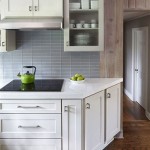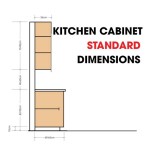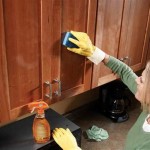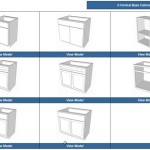How To Fit Kitchen Drawer Handles: A Comprehensive Guide
Refacing or upgrading kitchen cabinets and drawers often involves replacing the hardware. Fitting new kitchen drawer handles can significantly improve the aesthetic appeal and functionality of a kitchen. This article provides a detailed guide on how to fit kitchen drawer handles, covering essential tools, preparation steps, installation techniques, and troubleshooting common issues.
Before beginning any project, it is crucial to understand the different types of drawer handles available. These can vary widely in style, material, and mounting method. Common types include knobs, pulls, and cup pulls. Knobs typically require a single screw for mounting, while pulls usually require two screws, offering increased stability and a more modern look. Cup pulls are often mounted with two screws as well, offering a vintage aesthetic.
The choice of handle should complement the overall design of the kitchen. Consider the style of the cabinets, the color scheme, and the desired functionality. For example, shaker-style cabinets often look best with simple, understated pulls, while modern kitchens might benefit from sleek, minimalist handles.
Key Point 1: Gathering Essential Tools and Materials
Before proceeding with the installation, gathering the necessary tools and materials is imperative for a smooth and efficient process. This step helps prevent interruptions and ensures that the project can be completed without delays.
The essential tools and materials include:
*New Drawer Handles:
The handles to be installed, ensuring they are compatible with the drawers. *Screwdriver:
Both a Phillips head and a flathead screwdriver may be needed, depending on the type of screws used with the handles. A power screwdriver can expedite the process, but care must be taken to avoid over-tightening. *Drill:
A drill with various drill bits is crucial for creating pilot holes and, if necessary, enlarging existing holes. *Measuring Tape:
A measuring tape is essential for accurately measuring the spacing between existing holes or determining the placement of new holes. *Pencil:
A pencil is needed for marking the locations for drilling pilot holes. *Level:
A small level can help ensure that the handles are installed straight. *Safety Glasses:
Protecting eyes from debris is crucial while drilling. *Work Gloves:
Gloves can improve grip and protect hands. *Drill Template or Jig (Optional):
A drill template or jig can aid in consistent and accurate hole placement, especially when installing multiple handles. Common jigs are adjustable to accommodate different hole spacings. *Painter's Tape (Optional):
Applying painter's tape to the drawer front before marking and drilling can help prevent chipping and splintering. *Screws:
Verify that the screws provided with the handles are the correct length and type for the drawers. If not, purchase appropriate screws separately. *Countersink Bit (Optional):
A countersink bit can create a beveled hole for the screw heads, ensuring they sit flush with the surface of the drawer.Having all the necessary tools and materials readily available streamlines the installation process and minimizes the risk of errors.
Key Point 2: Preparing the Drawers for Handle Installation
Proper preparation of the drawers is critical for achieving a professional and aesthetically pleasing result. This involves removing old handles, cleaning the drawer fronts, and accurately marking the locations for new holes, if required.
The preparation steps include:
*Remove Existing Handles:
Begin by removing any existing handles or knobs from the drawers. Use the appropriate screwdriver to loosen and remove the screws. Preserve the old handles and screws in case they are needed in the future. *Clean the Drawer Fronts:
Thoroughly clean the drawer fronts to remove any dirt, grease, or residue. Use a mild detergent and a damp cloth. Dry the drawer fronts completely before proceeding. *Evaluate Existing Holes:
Examine the existing holes (if any). If the new handles have the same hole spacing, ensure the holes are clean and free of obstructions. If new holes are required, the existing holes may need to be filled with wood filler and sanded smooth before drilling new holes. *Fill Unwanted Holes (If Necessary):
If the new handles require different hole spacing, fill the existing holes with wood filler. Allow the filler to dry completely according to the manufacturer's instructions. Sand the filled areas smooth and flush with the drawer front. *Mark Hole Locations:
Accurately mark the locations for the new handle holes. Use a measuring tape to determine the center point of the drawer front. Measure and mark the distance from the center point to each hole location, based on the handle's hole spacing. Use a pencil to make clear and precise marks. A drill template or jig can simplify this process, ensuring consistent hole placement across all drawers. *Use Painter's Tape (Optional):
Apply painter's tape to the drawer front where the holes will be drilled. This helps prevent chipping or splintering of the wood or laminate surface. *Double-Check Measurements:
Before drilling, double-check all measurements and markings to ensure accuracy. Incorrect hole placement can result in misaligned handles and require additional repairs.Taking the time to properly prepare the drawers ensures that the new handles are installed correctly and securely, resulting in a professional-looking finish.
Key Point 3: Installing the New Drawer Handles
With the drawers prepared and hole locations marked, the next step is to install the new drawer handles. This involves drilling pilot holes, attaching the handles with screws, and ensuring they are securely fastened.
The installation steps include:
*Drill Pilot Holes:
Using a drill, carefully drill pilot holes at the marked locations. Use a drill bit that is slightly smaller than the diameter of the screws being used. Drilling pilot holes helps prevent splitting or cracking of the wood and makes it easier to insert the screws. *Use Correct Drill Bit Size:
Selecting the correct drill bit size is crucial. If the bit is too large, the screws will not grip properly, and the handles may be loose. If the bit is too small, it may be difficult to insert the screws, and the wood may crack. *Drill Straight:
Ensure that the drill is held perpendicular to the drawer front when drilling pilot holes. This helps ensure that the screws will be inserted straight and that the handles will be aligned properly. *Countersink (Optional):
If desired, use a countersink bit to create a beveled hole for the screw heads. This allows the screw heads to sit flush with the surface of the drawer, creating a cleaner look. *Attach the Handles:
Align the new handles with the pilot holes and insert the screws. Use a screwdriver to tighten the screws, but avoid over-tightening, which can damage the drawer front or strip the screw heads. *Check for Alignment:
After installing each handle, check its alignment to ensure it is straight and level. Use a small level if necessary. Adjust the handle as needed before fully tightening the screws. *Secure the Handles:
Once the handle is properly aligned, tighten the screws securely. Check that the handle is firmly attached to the drawer front and does not wobble or move. *Repeat for All Drawers:
Repeat the process for all remaining drawers, ensuring that each handle is installed correctly and securely. *Inspect the Installation:
After installing all the handles, inspect the installation carefully. Check for any loose screws, misaligned handles, or other issues. Make any necessary adjustments to ensure that all handles are properly installed and functioning correctly.Following these steps ensures that the new drawer handles are installed securely and accurately, enhancing the appearance and functionality of the kitchen.
After completing the installation, it is advisable to test the drawers to ensure they open and close smoothly with the new handles. Any minor adjustments can be made at this stage to optimize the user experience. For example, the tension of the drawer slides might need adjustment if the new handles are heavier than the old ones.
Regularly inspect the handles and tighten any loose screws as needed to maintain their stability and functionality over time. This simple maintenance task prevents potential issues and prolongs the lifespan of the hardware.
The process of fitting kitchen drawer handles, while seemingly straightforward, involves several critical steps that require attention to detail. Proper preparation, accurate measurements, and careful installation are essential for achieving a professional and long-lasting result. By following the guidelines outlined in this article, individuals can confidently undertake this project and enhance the aesthetic appeal and functionality of their kitchens.

How To Install Cabinet Handles Ultimate Stress Free Tips

How To Install Hardware Like A Pro Kitchen Renovation House Of Hepworths

How To Install Cabinet Door And Drawer Handles Knobs Pulls

How To Fit A Cupboard Handle

How To Install Cabinet Handles Ultimate Stress Free Tips

Mistakes To Avoid When You Install Kitchen Cabinet Pulls Free Template

Painted Furniture Ideas How To Resize Drawer Pull Holes Fit Standard Pulls

How To Install Cabinet Handles Ultimate Stress Free Tips

The Fastest Easiest Way To Install Cabinet Handles

Install New Cabinet Pulls The Easy Way
Related Posts








